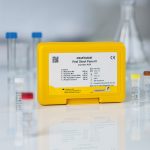Intended use:
For in vitro diagnostic use. The RIDA®GENE Parainfluenza test, performed on Roche LightCycler® 480 II, is a multiplex real-time RT-PCR for the direct qualitative detection and differentiation of parainfluenza 1, parainfluenza 3, and parainfluenza 2/4 RNA in untreated human nasal/throat swabs from persons with signs and symptoms of acute respiratory infection.
The RIDA®GENE Parainfluenza test is intended to support the diagnosis of parainfluenza (parainfluenza 1, parainfluenza 3, and parainfluenza 2/4) infections in patients with symptoms of respiratory infection in connection with other clinical and laboratory findings.
Negative results do not rule out infection with parainfluenza virus (parainfluenza 1, parainfluenza 3, and parainfluenza 2/4) and should not be used as the sole basis for diagnosis.
The product is intended for professional use.
General information:
Human parainfluenza viruses (HPIVs) are enveloped, single-stranded RNA viruses from the family Paramyxoviridae. They can cause a number of respiratory illnesses, by initially infecting the pseudostratified mucociliary airway epithelium of the nose and oropharynx before spreading to the large and small airways. HPIVs are the second leading cause of hospitalizations in children under age 5 and are responsible for up to 17 % of hospitalizations.
HPIVs can be divided genetically and antigenically into four serotypes that can infect humans: HPIV-1, HPIV-2, HPIV-3, and HPIV-4. HPIV-1 and -3 belong to the genus Respirovirus, while HPIV-2 and -4 are classified in the genus Rubulavirus. The clinical presentation varies from type to type: HPIV-1 and -2 often cause croup and flu-like symptoms, while HPIV-3 is commonly associated with pneumonia and bronchiolitis. So far, HPIV-4 is not as well characterized, but it is suspected to have a clinical presentation similar to that of HPIV-3. Even the seasonal pattern is different among the four serotypes: HPIV-1 usually occurs in the fall of odd-numbered years, while HPIV-2 occurs in the fall of even-numbered years. HPIV-3 infections break out annually from April to June and are, therefore, the main cause of clinically significant infections among parainfluenza viruses. For instance, 60 % of children aged 2 years are infected with HPIV-3, while the number increases to 80 % among children up to 4 years old. Generally, infants, toddlers, older people, and immunocompromised people have a higher risk of a severe HPIV infection, while the HPIV infection in healthy adults is usually limited to mild symptoms of the upper airways. HPIV is normally transmitted from human to human through the air from coughing and sneezing, by close human contact, or by touching of hands or objects containing HPIV and then touching the mouth, eyes, or nose.
Image Gallery
| Art. No. | PG5805 |
|---|---|
| Test format | real-time RT-PCR with 100 reactions |
| Shelf life | 24 months after production |
| Sensitivity | Analytical Sensitivity : ≥ 50 RNA copies per reaction |
Dear customers,
we have started to provide the documents for our products in an electronic format. These are the Instructions for Use (IFU), the Safety Data Sheets (SDS) and the Certificate of Analysis (CoA). For batches placed on the market after 01 January 2023, you can find our documents on the eIFU portal eifu.r-biopharm.com/clinic.













